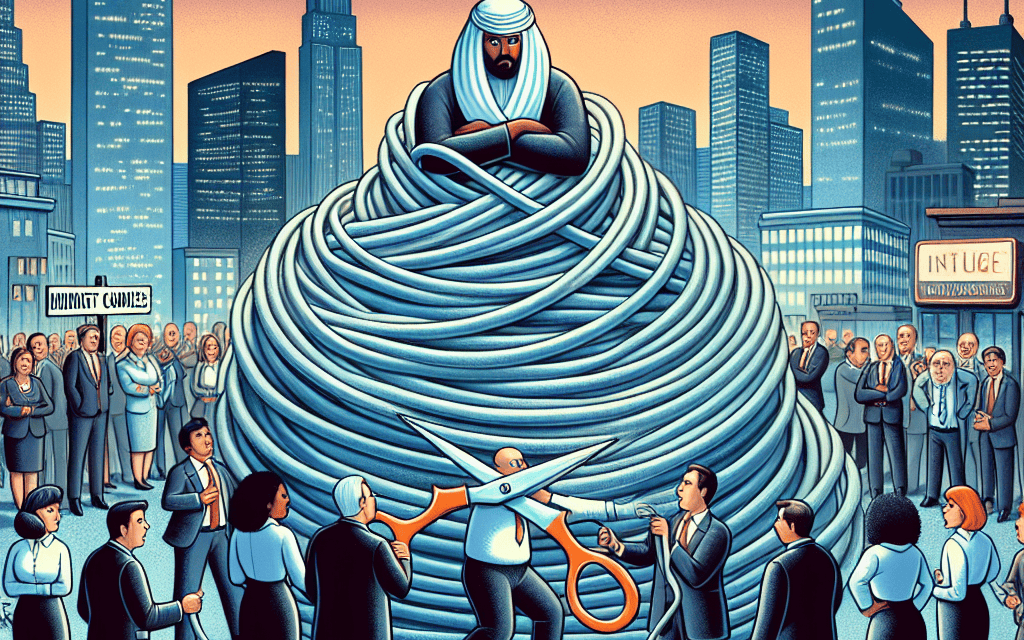“Unplugging the Future: Cable Companies Confront the Broadband Cord-Cutting Revolution”
Introduction
In recent years, cable companies have encountered a formidable new challenge: the rise of broadband cord-cutting. As consumers increasingly seek more flexible and cost-effective alternatives to traditional cable television, many are opting to sever their ties with cable providers in favor of internet-based streaming services. This shift is driven by the proliferation of high-speed internet access, the growing availability of diverse streaming platforms, and changing consumer preferences that prioritize on-demand content and personalized viewing experiences. As a result, cable companies are grappling with the need to adapt their business models to retain subscribers and remain competitive in an evolving digital landscape.
Impact Of Broadband Cord-Cutting On Cable Companies
The landscape of the telecommunications industry is undergoing a significant transformation as cable companies face a new challenge: broadband cord-cutting. This phenomenon, characterized by consumers opting to cancel their traditional broadband services in favor of alternative internet solutions, is reshaping the way cable companies operate and strategize for the future. As more consumers seek flexibility, affordability, and enhanced connectivity, the impact of broadband cord-cutting on cable companies is becoming increasingly pronounced.
To begin with, the rise of broadband cord-cutting can be attributed to the proliferation of alternative internet service providers and technologies. With the advent of 5G networks, satellite internet, and fiber-optic connections, consumers now have a plethora of options that promise faster speeds and more reliable service. These alternatives often come at competitive prices, making them attractive to consumers who are dissatisfied with the traditional cable broadband offerings. Consequently, cable companies are witnessing a decline in their subscriber base, which directly affects their revenue streams.
Moreover, the shift towards broadband cord-cutting is not solely driven by technological advancements but also by changing consumer preferences. Today’s consumers are increasingly prioritizing flexibility and customization in their internet services. They seek plans that cater to their specific needs, whether it be for streaming, gaming, or remote work. Traditional cable companies, with their often rigid and bundled service packages, struggle to meet these evolving demands. As a result, consumers are more inclined to explore alternative providers that offer tailored solutions, further exacerbating the challenges faced by cable companies.
In addition to the loss of subscribers, cable companies are also grappling with the financial implications of broadband cord-cutting. The reduction in customer base leads to decreased revenue, which in turn affects their ability to invest in infrastructure and innovation. This creates a vicious cycle where the lack of investment hampers their competitiveness, making it even more difficult to retain existing customers or attract new ones. Furthermore, the pressure to lower prices in response to competition from alternative providers can erode profit margins, putting additional strain on cable companies’ financial health.
Despite these challenges, cable companies are not without recourse. To mitigate the impact of broadband cord-cutting, many are diversifying their service offerings and investing in new technologies. For instance, some are expanding their fiber-optic networks to provide faster and more reliable internet services. Others are exploring partnerships with streaming services and content providers to offer bundled packages that appeal to consumers’ desire for comprehensive entertainment solutions. By adapting to the changing market dynamics, cable companies can position themselves to better compete with emerging internet service providers.
Furthermore, cable companies are increasingly focusing on customer experience as a differentiating factor. By enhancing customer service, offering flexible plans, and providing value-added services, they aim to retain their existing customer base and attract new subscribers. This customer-centric approach is crucial in an era where consumers have more choices than ever before.
In conclusion, the impact of broadband cord-cutting on cable companies is profound and multifaceted. As consumers continue to seek alternative internet solutions, cable companies must navigate the challenges of declining subscriber numbers and financial pressures. However, by embracing innovation, diversifying their offerings, and prioritizing customer experience, they can adapt to the evolving telecommunications landscape and remain competitive in the face of this new challenge.
Strategies For Cable Companies To Combat Broadband Cord-Cutting
As the digital landscape continues to evolve, cable companies are encountering a new challenge that threatens their traditional business model: broadband cord-cutting. This phenomenon, characterized by consumers opting to cancel their broadband subscriptions in favor of alternative internet solutions, is gaining momentum. To address this emerging trend, cable companies must develop innovative strategies that not only retain their existing customer base but also attract new subscribers. By understanding the underlying reasons for broadband cord-cutting and implementing effective countermeasures, cable companies can navigate this shifting terrain with greater agility.
One of the primary drivers of broadband cord-cutting is the increasing availability of alternative internet services, such as 5G wireless networks and satellite internet. These technologies offer competitive speeds and reliability, often at a lower cost than traditional broadband services. To combat this, cable companies must focus on enhancing the value proposition of their broadband offerings. This can be achieved by investing in infrastructure upgrades to provide faster and more reliable internet connections. By doing so, they can ensure that their services remain competitive in terms of speed and performance, thereby reducing the incentive for customers to switch to alternative providers.
In addition to infrastructure improvements, cable companies should consider diversifying their service offerings to create bundled packages that appeal to a broader audience. By combining broadband services with other products, such as streaming subscriptions, home security systems, or smart home devices, they can offer a more comprehensive and attractive package to consumers. This approach not only adds value for the customer but also increases the perceived cost of switching to a different provider, thereby enhancing customer retention.
Moreover, customer service plays a crucial role in combating broadband cord-cutting. In an era where consumers have numerous options at their disposal, providing exceptional customer service can be a significant differentiator. Cable companies should invest in training their customer service representatives to handle inquiries and issues efficiently and courteously. Additionally, implementing user-friendly online platforms for account management and support can enhance the overall customer experience, making it less likely for subscribers to seek alternatives.
Furthermore, cable companies can leverage data analytics to gain insights into customer behavior and preferences. By analyzing usage patterns and feedback, they can identify potential areas for improvement and tailor their services to better meet the needs of their customers. This data-driven approach allows for more personalized marketing strategies, which can be instrumental in retaining existing customers and attracting new ones.
Another strategy involves fostering partnerships with content providers and technology companies. By collaborating with these entities, cable companies can offer exclusive content or innovative technologies that are not available through other internet service providers. This exclusivity can serve as a compelling reason for consumers to choose and remain with a particular broadband provider.
Finally, cable companies should actively engage in public relations and marketing campaigns to communicate the benefits of their broadband services. By highlighting the advantages of their offerings, such as superior speed, reliability, and customer support, they can effectively counteract the appeal of alternative internet solutions. Additionally, educating consumers about the potential limitations and drawbacks of emerging technologies, such as coverage gaps or data caps, can further reinforce the value of traditional broadband services.
In conclusion, as broadband cord-cutting becomes an increasingly prevalent challenge, cable companies must adopt a multifaceted approach to remain competitive. By enhancing their infrastructure, diversifying service offerings, prioritizing customer service, leveraging data analytics, forming strategic partnerships, and engaging in effective marketing, they can successfully navigate this evolving landscape and secure their position in the market.
The Rise Of Streaming Services And Its Effect On Cable Providers
The advent of streaming services has significantly altered the landscape of media consumption, presenting a formidable challenge to traditional cable providers. As consumers increasingly gravitate towards digital platforms, the phenomenon of broadband cord-cutting has emerged, posing a new threat to cable companies. This shift is not merely a trend but a profound transformation in how audiences access and engage with content. The rise of streaming services such as Netflix, Hulu, and Amazon Prime Video has revolutionized the entertainment industry, offering viewers unprecedented flexibility and choice. Unlike traditional cable packages, which often require long-term contracts and include numerous channels that may go unwatched, streaming services provide on-demand access to a vast array of content. This model appeals to modern consumers who prioritize convenience and personalization, allowing them to watch what they want, when they want, and on any device.
Moreover, the cost-effectiveness of streaming services cannot be overlooked. With the ability to subscribe to multiple platforms for a fraction of the cost of a comprehensive cable package, consumers are finding it increasingly difficult to justify the expense of traditional cable. This economic advantage is further amplified by the absence of hidden fees and the ability to cancel subscriptions without penalty, making streaming an attractive alternative for budget-conscious households. As a result, cable companies are witnessing a steady decline in subscribers, a trend that shows no signs of abating.
In response to this shift, cable providers are being forced to innovate and adapt. Many are investing in their own streaming platforms, seeking to capture a share of the digital market. For instance, Comcast’s Peacock and AT&T’s HBO Max represent efforts by traditional media giants to remain relevant in an increasingly digital world. These platforms aim to leverage existing content libraries while also investing in original programming to attract and retain subscribers. However, the success of these ventures is not guaranteed, as they face stiff competition from established streaming giants and new entrants alike.
Furthermore, cable companies are exploring partnerships with streaming services to offer bundled packages that combine traditional cable with digital offerings. This strategy aims to provide consumers with the best of both worlds, appealing to those who still value live television and sports but also desire the flexibility of streaming. By integrating streaming services into their offerings, cable providers hope to stem the tide of cord-cutting and retain their customer base.
Nevertheless, the challenges facing cable companies extend beyond competition from streaming services. The rapid advancement of technology and the proliferation of high-speed internet have empowered consumers to access content directly from creators, bypassing traditional distribution channels altogether. Platforms like YouTube and TikTok have democratized content creation, allowing individuals to reach global audiences without the need for a cable network. This shift further erodes the traditional cable model, as consumers increasingly turn to these platforms for entertainment and information.
In conclusion, the rise of streaming services has fundamentally reshaped the media landscape, presenting significant challenges for cable providers. As consumers continue to embrace digital platforms, cable companies must innovate and adapt to remain competitive. Whether through the development of their own streaming services, strategic partnerships, or other innovative solutions, the future of cable will depend on their ability to navigate this rapidly changing environment. The era of broadband cord-cutting is here, and its impact on the cable industry is both profound and irreversible.
How Cable Companies Are Adapting To The Broadband Cord-Cutting Trend

As the digital landscape continues to evolve, cable companies are encountering a new challenge that threatens their traditional business model: broadband cord-cutting. This phenomenon, characterized by consumers opting to cancel their broadband subscriptions in favor of alternative internet solutions, is reshaping the telecommunications industry. To remain competitive, cable companies are compelled to adapt to this trend by innovating and diversifying their offerings.
Initially, the rise of streaming services prompted a wave of cord-cutting, with consumers abandoning traditional cable television packages. However, the current trend of broadband cord-cutting presents a more complex challenge, as it involves the very infrastructure that supports these streaming services. Consumers are increasingly exploring options such as 5G wireless networks, satellite internet, and community broadband initiatives, which promise faster speeds and more competitive pricing. Consequently, cable companies must rethink their strategies to retain customers and attract new ones.
In response to this shift, many cable companies are investing heavily in upgrading their existing infrastructure. By enhancing the speed and reliability of their broadband services, they aim to offer a superior internet experience that can compete with emerging technologies. For instance, the deployment of fiber-optic networks is a significant step in this direction, as it provides high-speed internet access with minimal latency. This investment not only addresses current consumer demands but also positions cable companies to accommodate future technological advancements.
Moreover, cable companies are diversifying their service portfolios to include more than just internet access. By bundling broadband with other services such as home security, smart home technology, and mobile phone plans, they create value-added packages that appeal to a broader audience. This approach not only enhances customer retention but also opens new revenue streams, mitigating the impact of broadband cord-cutting.
In addition to infrastructure upgrades and service diversification, cable companies are focusing on customer experience as a key differentiator. Recognizing that consumers have more choices than ever, these companies are striving to improve customer service and support. By offering personalized service plans, flexible pricing options, and responsive customer care, they aim to build stronger relationships with their clientele. This customer-centric approach is crucial in an era where consumer loyalty is increasingly driven by the quality of service rather than brand allegiance.
Furthermore, strategic partnerships and collaborations are becoming essential for cable companies navigating the broadband cord-cutting trend. By aligning with technology firms, content providers, and other industry players, they can leverage synergies to enhance their offerings. For example, partnerships with streaming platforms can provide exclusive content bundles, while collaborations with tech companies can facilitate the integration of cutting-edge technologies into their service offerings.
As cable companies adapt to the broadband cord-cutting trend, regulatory considerations also play a significant role. Policymakers are increasingly scrutinizing the telecommunications industry to ensure fair competition and consumer protection. Cable companies must navigate this regulatory landscape carefully, advocating for policies that support innovation while complying with existing regulations.
In conclusion, the broadband cord-cutting trend presents both challenges and opportunities for cable companies. By investing in infrastructure, diversifying services, enhancing customer experience, and forming strategic partnerships, they can effectively adapt to this evolving market. As the telecommunications industry continues to transform, cable companies that embrace change and prioritize innovation will be well-positioned to thrive in the digital age.
Consumer Preferences: Why Broadband Cord-Cutting Is Gaining Popularity
In recent years, the telecommunications landscape has undergone a significant transformation, with broadband cord-cutting emerging as a notable trend among consumers. This shift, driven by evolving consumer preferences, poses a new challenge for traditional cable companies. As more individuals seek flexibility and cost-effectiveness in their internet services, the appeal of broadband cord-cutting continues to grow. Understanding the factors contributing to this trend is crucial for both consumers and industry stakeholders.
To begin with, the rise of broadband cord-cutting can be attributed to the increasing availability and affordability of high-speed internet services. As internet infrastructure improves, more consumers have access to reliable and fast broadband connections, making it feasible to forego traditional cable services. This development has empowered consumers to explore alternative options that better suit their needs and preferences. Moreover, the proliferation of streaming services has played a pivotal role in this shift. Platforms such as Netflix, Hulu, and Amazon Prime Video offer a vast array of content that can be accessed on-demand, providing a level of convenience and choice that traditional cable packages often lack.
In addition to the allure of streaming services, the cost factor cannot be overlooked. Traditional cable subscriptions often come with hefty monthly fees, which can be a significant burden for many households. In contrast, broadband-only plans tend to be more affordable, allowing consumers to allocate their resources more efficiently. This financial consideration is particularly appealing to younger demographics, who are more likely to prioritize cost savings and flexibility over the bundled offerings of cable companies. As a result, broadband cord-cutting has gained traction among millennials and Generation Z, who are reshaping the market with their distinct preferences.
Furthermore, the desire for customization and control over content consumption is another driving force behind the broadband cord-cutting trend. Consumers today are increasingly seeking personalized experiences, and broadband services offer the flexibility to tailor internet usage to individual needs. This shift towards customization is evident in the growing popularity of smart home devices and the Internet of Things (IoT), which require robust and adaptable internet connections. By opting for broadband-only plans, consumers can better manage their internet usage, ensuring that their connectivity aligns with their specific requirements.
As broadband cord-cutting gains momentum, cable companies are compelled to adapt to this changing landscape. To remain competitive, they must innovate and diversify their offerings, focusing on providing value-added services that complement broadband connections. This may include bundling internet services with home security solutions, cloud storage, or enhanced customer support. By doing so, cable companies can retain their customer base while attracting new subscribers who are drawn to the benefits of broadband connectivity.
In conclusion, the trend of broadband cord-cutting reflects a broader shift in consumer preferences towards flexibility, affordability, and customization. As high-speed internet becomes more accessible and streaming services continue to flourish, traditional cable companies face the challenge of adapting to this new reality. By understanding the motivations behind broadband cord-cutting and responding with innovative solutions, these companies can navigate the evolving telecommunications landscape and meet the demands of modern consumers. As this trend continues to unfold, it will be interesting to observe how both consumers and industry players adapt to the changing dynamics of internet services.
Future Of Cable Companies In A Broadband-Driven World
As the digital landscape continues to evolve, cable companies are encountering a formidable challenge: the rise of broadband cord-cutting. This phenomenon, characterized by consumers opting to sever their traditional cable subscriptions in favor of internet-based services, is reshaping the future of cable companies in a broadband-driven world. The shift is not merely a trend but a significant transformation in consumer behavior, driven by the increasing availability and affordability of high-speed internet and the proliferation of streaming services.
To understand the implications of broadband cord-cutting, it is essential to consider the factors contributing to this shift. First and foremost, the rapid advancement in internet technology has made high-speed broadband more accessible to a broader audience. This accessibility has empowered consumers to explore alternative content delivery methods, such as streaming platforms, which offer a more flexible and often more affordable viewing experience compared to traditional cable packages. Moreover, the diverse range of content available on these platforms, from original series to live sports, has further enticed viewers to make the switch.
In addition to technological advancements, changing consumer preferences play a crucial role in this transition. Today’s viewers demand greater control over their viewing experiences, seeking the ability to watch content on-demand and on multiple devices. Streaming services cater to these preferences by offering personalized content recommendations and the convenience of watching anytime, anywhere. This level of customization and flexibility is something that traditional cable services have struggled to match, leading to a growing number of consumers cutting the cord.
As cable companies grapple with this new reality, they are exploring various strategies to remain competitive in a broadband-driven world. One approach is to enhance their own broadband offerings, recognizing that high-speed internet is now a fundamental component of modern households. By investing in infrastructure and improving internet speeds, cable companies can position themselves as essential providers of broadband services, even if their traditional television offerings decline.
Furthermore, some cable companies are diversifying their portfolios by entering the streaming market themselves. By launching their own streaming platforms or partnering with existing ones, they aim to capture a share of the growing demand for online content. This strategy not only allows them to retain existing customers but also attracts new ones who are primarily interested in streaming services. However, this approach requires significant investment and innovation to compete with established streaming giants.
Another potential avenue for cable companies is to focus on bundling services. By offering packages that combine broadband, streaming, and other services such as home security or mobile plans, they can provide added value to consumers. This bundling strategy can help cable companies differentiate themselves in a crowded market and encourage customer loyalty.
Despite these efforts, the future of cable companies in a broadband-driven world remains uncertain. The pace of technological change and evolving consumer preferences continue to challenge traditional business models. To thrive in this environment, cable companies must be agile, willing to adapt, and open to embracing new technologies and partnerships. Ultimately, their success will depend on their ability to innovate and meet the demands of a digitally-savvy audience.
In conclusion, the rise of broadband cord-cutting presents both challenges and opportunities for cable companies. As they navigate this shifting landscape, they must focus on enhancing their broadband services, exploring new business models, and delivering value to consumers. By doing so, they can secure their place in a future where broadband reigns supreme.
Innovations In Cable Services To Retain Customers Amid Cord-Cutting
In recent years, the telecommunications landscape has undergone a significant transformation, with traditional cable companies facing unprecedented challenges due to the rise of broadband cord-cutting. As consumers increasingly opt for internet-based streaming services over conventional cable television, cable providers are compelled to innovate and adapt to retain their customer base. This shift in consumer behavior is driven by a combination of factors, including the proliferation of high-speed internet, the growing popularity of on-demand content, and the desire for more flexible viewing options. Consequently, cable companies are exploring various strategies to remain competitive in this rapidly evolving market.
One of the primary strategies being employed by cable companies is the enhancement of their broadband services. Recognizing that high-speed internet is the backbone of modern entertainment consumption, these companies are investing heavily in upgrading their infrastructure to offer faster and more reliable internet connections. By doing so, they aim to position themselves as indispensable providers of the very service that enables streaming and other online activities. This approach not only helps retain existing customers but also attracts new ones who prioritize internet speed and reliability.
In addition to improving broadband services, cable companies are diversifying their offerings to include streaming platforms and on-demand content. By partnering with popular streaming services or developing their own platforms, they can provide customers with a comprehensive entertainment package that combines traditional cable channels with the flexibility of streaming. This hybrid model allows consumers to enjoy the best of both worlds, thereby reducing the incentive to cut the cord entirely. Moreover, by bundling these services with their internet packages, cable companies can offer competitive pricing that appeals to cost-conscious consumers.
Another innovative approach being adopted is the personalization of content. Cable companies are leveraging data analytics to gain insights into customer preferences and viewing habits. This information enables them to tailor their offerings to individual tastes, providing a more personalized and engaging experience. For instance, by recommending shows and movies based on past viewing behavior, cable providers can enhance customer satisfaction and loyalty. This level of personalization is increasingly expected by consumers who are accustomed to the algorithms used by streaming giants like Netflix and Amazon Prime Video.
Furthermore, cable companies are exploring the integration of advanced technologies such as artificial intelligence and virtual reality to enhance the viewing experience. AI-powered voice assistants, for example, can simplify content discovery and navigation, making it easier for users to find what they want to watch. Meanwhile, virtual reality offers the potential for immersive viewing experiences that go beyond traditional television. By staying at the forefront of technological advancements, cable companies can differentiate themselves from competitors and offer unique value propositions to their customers.
Despite these efforts, the challenge of broadband cord-cutting remains formidable. The convenience, affordability, and vast content libraries offered by streaming services continue to lure consumers away from traditional cable subscriptions. However, by embracing innovation and adapting to changing consumer preferences, cable companies can mitigate the impact of this trend and maintain their relevance in the digital age. As the industry continues to evolve, the ability to anticipate and respond to consumer demands will be crucial for cable providers seeking to thrive in an increasingly competitive environment. Through strategic investments in technology and a commitment to customer-centric solutions, cable companies can navigate the challenges of broadband cord-cutting and secure their place in the future of entertainment.
Q&A
1. **What is broadband cord-cutting?**
Broadband cord-cutting refers to consumers canceling their traditional internet service subscriptions in favor of alternative internet access options, such as mobile data plans or community broadband networks.
2. **Why are consumers opting for broadband cord-cutting?**
Consumers are opting for broadband cord-cutting due to the increasing availability and affordability of mobile data plans, dissatisfaction with cable companies’ pricing and service, and the rise of alternative internet providers.
3. **How are cable companies responding to broadband cord-cutting?**
Cable companies are responding by offering bundled services, improving customer service, investing in infrastructure to provide faster internet speeds, and exploring new revenue streams like streaming services.
4. **What impact does broadband cord-cutting have on cable companies’ revenue?**
Broadband cord-cutting can lead to a decline in cable companies’ revenue from traditional internet services, forcing them to adapt their business models and find new ways to retain customers.
5. **Are there any technological advancements contributing to broadband cord-cutting?**
Yes, advancements such as 5G technology, improved mobile networks, and the proliferation of Wi-Fi hotspots contribute to broadband cord-cutting by providing viable alternatives to traditional broadband services.
6. **What demographic is most likely to engage in broadband cord-cutting?**
Younger consumers, particularly millennials and Gen Z, are more likely to engage in broadband cord-cutting due to their comfort with technology and preference for flexible, cost-effective internet solutions.
7. **What future trends might influence broadband cord-cutting?**
Future trends include the expansion of 5G networks, increased competition from alternative internet providers, and the potential for regulatory changes that could impact the broadband market landscape.
Conclusion
The rise of broadband cord-cutting presents a significant challenge for cable companies, as consumers increasingly opt for internet-based streaming services over traditional cable subscriptions. This shift is driven by the demand for more flexible, cost-effective, and personalized viewing options. As a result, cable companies must innovate and adapt by enhancing their broadband offerings, investing in streaming services, and exploring new revenue models to remain competitive in a rapidly evolving digital landscape. Failure to do so could lead to a decline in their market share and relevance in the telecommunications industry.





